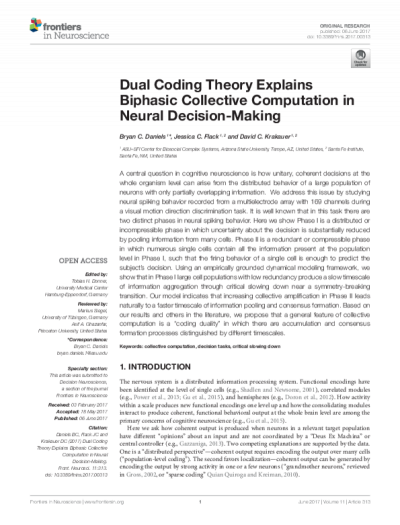A central question in cognitive neuroscience is how unitary, coherent decisions at the whole organism level can arise from the distributed behavior of a large population of neurons with only partially overlapping information. We address this issue by studying neural spiking behavior recorded from a multielectrode array with 169 channels during a visual motion direction discrimination task. It is well known that in this task there are two distinct phases in neural spiking behavior. Here we show Phase I is a distributed or incompressible phase in which uncertainty about the decision is substantially reduced by pooling information from many cells. Phase II is a redundant or compressible phase in which numerous single cells contain all the information present at the population level in Phase I, such that the firing behavior of a single cell is enough to predict the subject's decision. Using an empirically grounded dynamical modeling framework, we show that in Phase I large cell populations with low redundancy produce a slow timescale of information aggregation through critical slowing down near a symmetry-breaking transition. Our model indicates that increasing collective amplification in Phase II leads naturally to a faster timescale of information pooling and consensus formation. Based on our results and others in the literature, we propose that a general feature of collective computation is a “coding duality” in which there are accumulation and consensus formation processes distinguished by different timescales.
Details
- Dual Coding Theory Explains Biphasic Collective Computation in Neural Decision-Making
- Daniels, Bryan (Author)
- Flack, Jessica (Author)
- Krakauer, David (Author)
- ASU-SFI Center for Biosocial Complex Systems (Contributor)
- Digital object identifier: 10.3389/fnins.2017.00313
- Identifier TypeInternational standard serial numberIdentifier Value1662-4548
- Identifier TypeInternational standard serial numberIdentifier Value1662-453X
- View the article as published at http://journal.frontiersin.org/article/10.3389/fnins.2017.00313/full
Citation and reuse
Cite this item
This is a suggested citation. Consult the appropriate style guide for specific citation guidelines.
Daniels, B. C., Flack, J. C., & Krakauer, D. C. (2017). Dual Coding Theory Explains Biphasic Collective Computation in Neural Decision-Making. Frontiers in Neuroscience, 11. doi:10.3389/fnins.2017.00313


